Green transportation options in Spain offer significant benefits, including reduced environmental impact and improved public health. This article explores the availability of electric vehicles, public transit systems, and cycling infrastructure. It also addresses regional disparities and challenges users face. Finally, recommendations for enhancing green transportation effectiveness will be discussed.
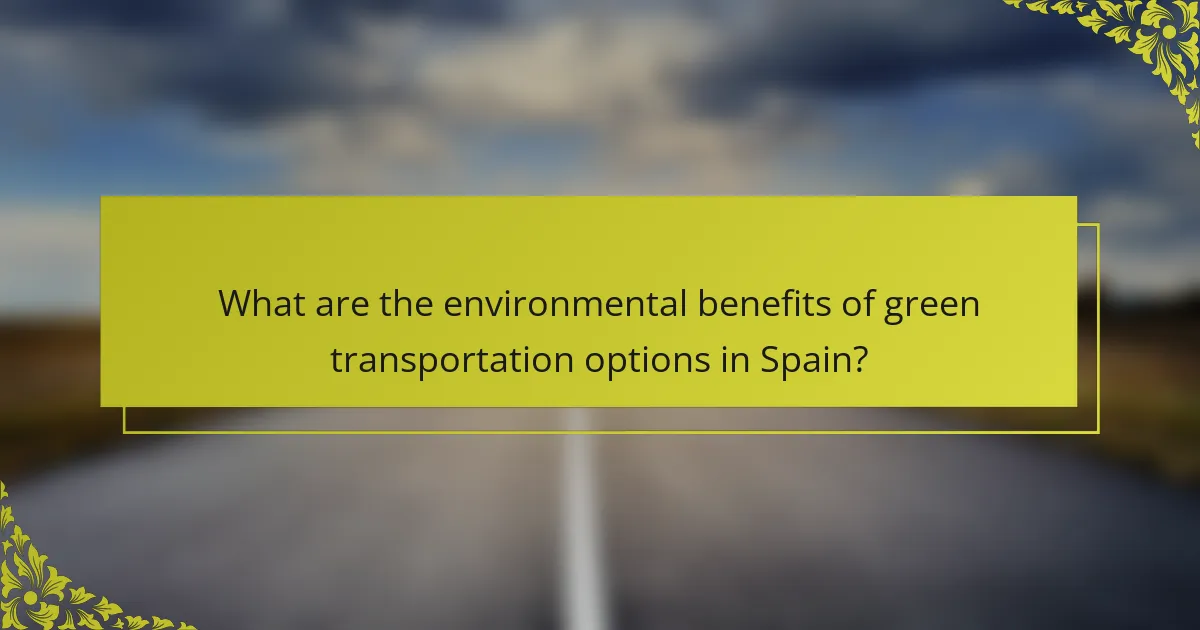
What are the environmental benefits of green transportation options in Spain?
Green transportation options in Spain significantly reduce environmental impact. They lower greenhouse gas emissions, improve air quality, and promote sustainable urban development.
Electric vehicles (EVs) contribute to decreased carbon footprints, with Spain aiming for 5 million EVs by 2030. Public transport systems, including buses and trains, are increasingly powered by renewable energy sources, enhancing their eco-friendliness.
Biking and walking infrastructure improvements lead to reduced traffic congestion and foster healthier lifestyles. As a result, cities like Barcelona and Madrid are implementing more bike lanes and pedestrian zones, further promoting green transportation.
Adopting these options supports Spain’s commitment to the Paris Agreement and its goal of achieving climate neutrality by 2050.
How do green transportation methods reduce carbon emissions?
Green transportation methods significantly reduce carbon emissions by using cleaner energy sources and promoting sustainable practices. Options like electric vehicles, bicycles, and public transit lower reliance on fossil fuels. For instance, electric vehicles emit zero tailpipe emissions, while cycling and walking produce no emissions at all. Additionally, public transportation systems can transport many passengers simultaneously, reducing the number of individual vehicles on the road. As a result, adopting these green transportation options contributes to cleaner air and a healthier environment in Spain.
What impact do green transportation options have on urban air quality?
Green transportation options significantly improve urban air quality by reducing vehicle emissions. These options include electric buses, bicycles, and car-sharing services, which collectively lower pollutants like nitrogen oxides and particulate matter. Studies show that cities implementing extensive green transportation networks experience up to a 30% reduction in air pollution levels. As a result, urban residents benefit from enhanced health outcomes and improved overall quality of life.
How do these options contribute to sustainable urban development?
Green transportation options in Spain significantly contribute to sustainable urban development by reducing emissions, enhancing public health, and promoting eco-friendly practices. These options, including electric buses, bike-sharing programs, and pedestrian-friendly infrastructures, encourage a shift from fossil fuel dependency.
For example, electric buses in cities like Madrid have decreased greenhouse gas emissions by over 30%. Bike-sharing initiatives in Barcelona have increased cycling rates by 20%, promoting active transportation. These benefits foster cleaner air, improved urban mobility, and a vibrant public realm, aligning with sustainability goals.
As a result, integrating green transportation enhances the quality of urban life and supports economic growth through increased accessibility. The promotion of these options is essential for creating resilient cities that prioritize environmental health and social equity.
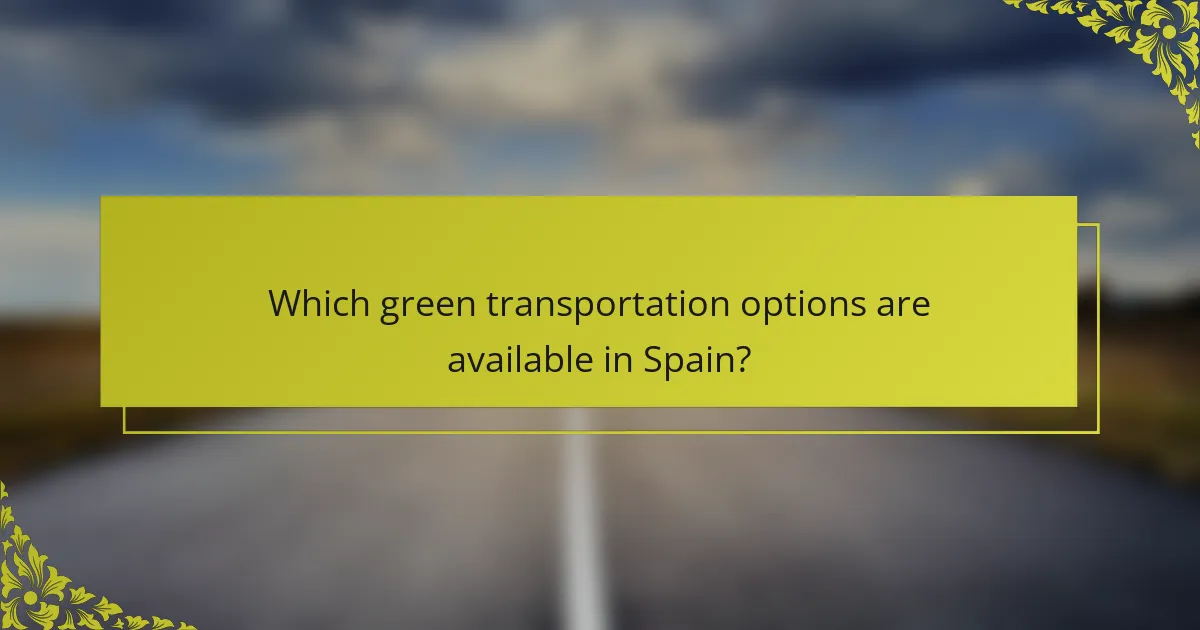
Which green transportation options are available in Spain?
Spain offers several green transportation options, including electric vehicles, public transit, cycling, and walking. These alternatives reduce carbon emissions and promote sustainability.
Electric vehicles are increasingly available, supported by a growing network of charging stations. Public transit systems, such as buses and trains, utilize cleaner technologies and provide extensive coverage across cities and regions. Cycling infrastructure is expanding, with dedicated lanes and bike-sharing programs enhancing accessibility. Walking remains a viable option in urban areas, encouraging healthy lifestyles while minimizing environmental impact.
Adopting these green transportation methods contributes to a cleaner environment and improved public health.
What role do electric vehicles play in Spain’s green transportation landscape?
Electric vehicles are crucial in Spain’s green transportation landscape, promoting sustainability and reducing emissions. Their adoption supports Spain’s commitment to climate goals and enhances urban air quality. The government incentivizes electric vehicle use through subsidies and infrastructure development, such as charging stations. As a result, electric vehicles are becoming increasingly accessible and popular among consumers, contributing significantly to the shift towards eco-friendly transportation options.
How are cycling and walking promoted as sustainable transport alternatives?
Cycling and walking are actively promoted in Spain as sustainable transport alternatives through infrastructure development and public awareness initiatives. Cities like Barcelona and Madrid have expanded bike lanes and pedestrian zones, making these options more accessible.
Government programs encourage cycling with bike-sharing schemes and subsidies for electric bikes. Walking is supported by improved sidewalks and safety measures, enhancing urban mobility.
As a result, both activities contribute to reduced carbon emissions and promote healthier lifestyles. In 2022, cycling accounted for 10% of urban trips in Spain, reflecting growing adoption.
What public transportation initiatives support green travel in Spanish cities?
Spanish cities implement various public transportation initiatives to promote green travel. These include expanded electric bus networks, bike-sharing programs, and pedestrian-friendly urban designs.
Electric buses reduce emissions and improve air quality. For instance, Madrid’s fleet includes over 200 electric buses, significantly lowering carbon output. Bike-sharing systems, such as Barcelona’s Bicing, encourage cycling as a sustainable transport option, with over 6,000 bikes available.
Cities also prioritize pedestrian zones, enhancing walkability and reducing reliance on cars. Valencia’s car-free initiatives in the city center demonstrate effective urban planning for greener mobility.
Overall, these initiatives collectively support environmentally friendly travel, contributing to sustainable urban development in Spain.
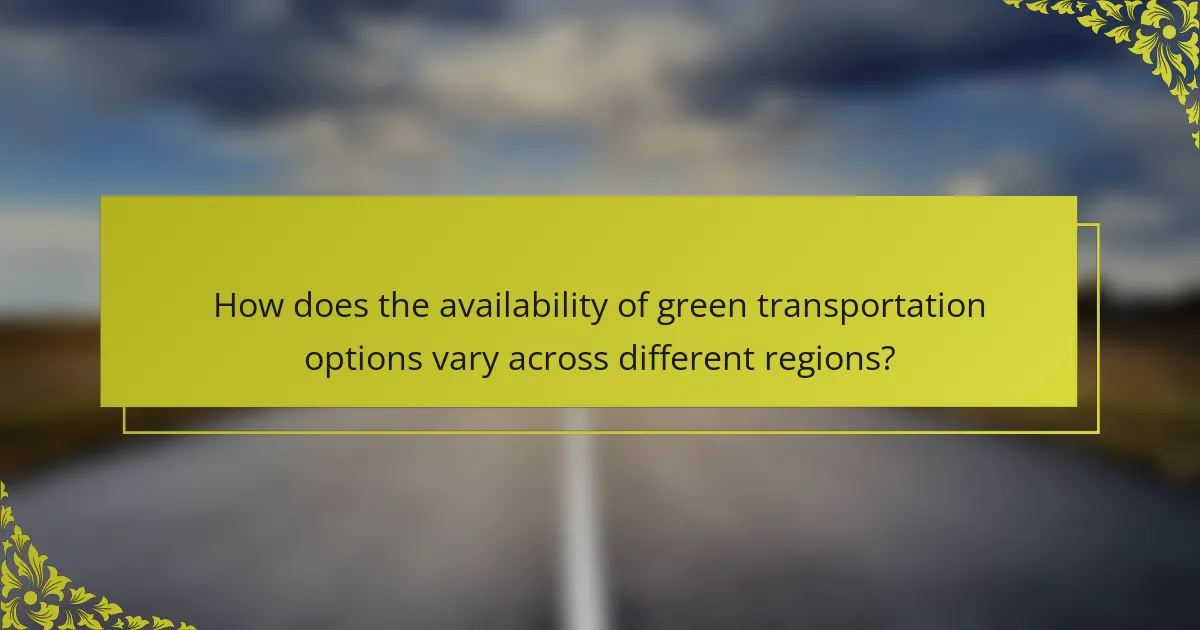
How does the availability of green transportation options vary across different regions?
The availability of green transportation options varies significantly across different regions in Spain. Urban areas like Madrid and Barcelona offer extensive electric vehicle charging stations and bike-sharing programs. In contrast, rural regions may have limited access to such services, reflecting disparities in infrastructure investment. As a result, urban populations benefit more from sustainable transportation options compared to their rural counterparts.
What urban areas in Spain lead in green transportation accessibility?
Barcelona, Madrid, and Valencia lead in green transportation accessibility in Spain. These urban areas prioritize eco-friendly transport options, including electric buses, bike-sharing programs, and extensive pedestrian zones.
Barcelona boasts over 200 kilometers of bike lanes and a successful electric scooter rental system. Madrid has implemented a low-emission zone, reducing vehicle traffic and promoting public transport. Valencia offers a well-integrated public transport network that emphasizes sustainability.
The commitment to green transportation in these cities not only enhances urban mobility but also contributes to improved air quality and reduced carbon emissions.
How do rural areas face challenges in adopting green transportation?
Rural areas face significant challenges in adopting green transportation due to limited infrastructure and financial resources. Many rural regions lack access to electric vehicle charging stations, making it difficult for residents to transition to electric vehicles. Additionally, the higher upfront costs of green transportation options can deter adoption in areas with lower average incomes. Public transportation options are often sparse, limiting the availability of eco-friendly travel methods. As a result, promoting green transportation in rural areas requires targeted investment and policy support to enhance accessibility and affordability.

What unique features differentiate green transportation options in Spain?
Green transportation options in Spain are distinguished by their sustainability, efficiency, and accessibility. Electric vehicles, bike-sharing programs, and public transport systems emphasize low emissions and renewable energy use. Unique features include extensive charging infrastructure for electric cars and dedicated bike lanes in major cities. Additionally, Spain’s commitment to reducing carbon footprints through government incentives enhances the appeal of these options. As a result, green transportation is increasingly integrated into urban planning, promoting eco-friendly travel choices.
How do local policies influence the adoption of electric scooters and bikes?
Local policies significantly influence the adoption of electric scooters and bikes in Spain by establishing regulations, infrastructure, and incentives. Effective policies promote safety, integrate these modes into public transport, and enhance accessibility. For example, cities like Barcelona have implemented dedicated lanes and parking spaces, increasing user confidence and convenience. Additionally, financial incentives encourage residents to choose green transportation options, reducing urban congestion and emissions. These measures collectively contribute to a growing acceptance and usage of electric scooters and bikes as viable alternatives to traditional vehicles.
What are the incentives for using green transportation in urban settings?
Green transportation in urban settings offers incentives such as reduced emissions, cost savings, and improved public health. These options, including electric vehicles, public transit, and cycling, enhance air quality and decrease traffic congestion. As a result, cities in Spain are increasingly adopting these methods to promote sustainable urban mobility.
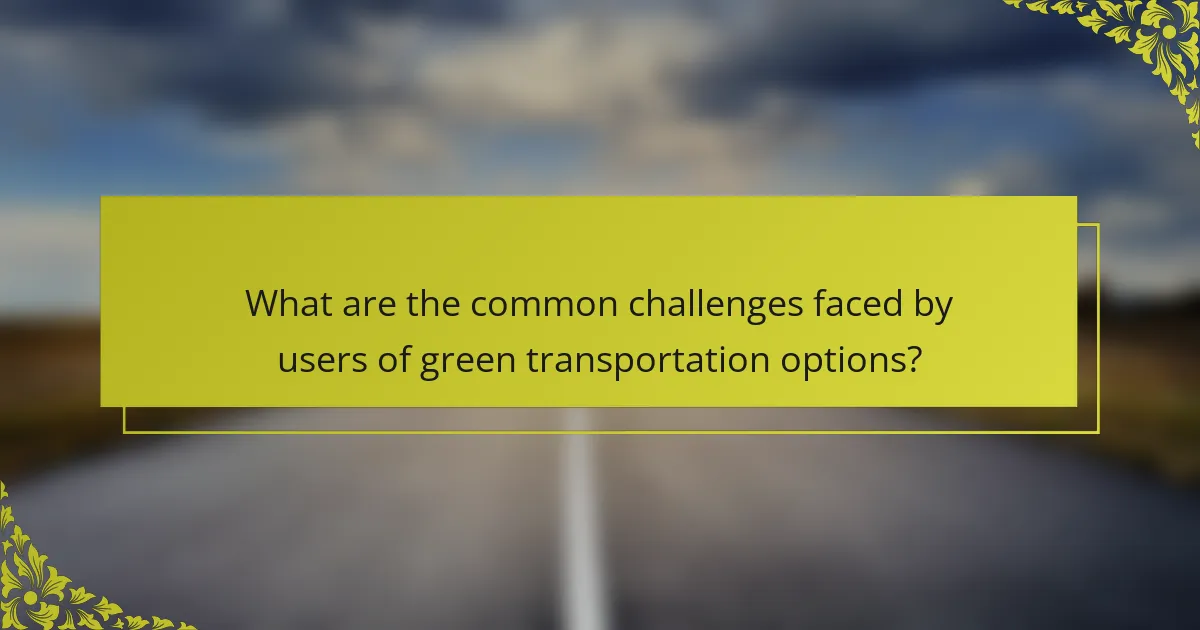
What are the common challenges faced by users of green transportation options?
Users of green transportation options in Spain commonly face challenges such as limited infrastructure, higher upfront costs, and lack of awareness. Limited charging stations for electric vehicles restrict travel flexibility. Higher initial investments in eco-friendly vehicles can deter potential buyers. Additionally, insufficient public knowledge about available options hampers adoption rates.
What barriers exist for the widespread adoption of electric vehicles?
The widespread adoption of electric vehicles in Spain faces several barriers. High purchase costs deter many consumers, despite lower operating expenses. Limited charging infrastructure creates range anxiety, hindering long-distance travel. Additionally, insufficient government incentives slow market growth. Consumer awareness about electric vehicle benefits remains low, affecting demand.
How does infrastructure impact the use of bicycles and public transport?
Infrastructure significantly enhances the use of bicycles and public transport by providing dedicated lanes, safe parking, and efficient transit systems. In Spain, cities like Barcelona and Madrid have invested in bike-sharing programs and expanded public transport networks, leading to increased ridership. The availability of bike lanes reduces accidents and encourages cycling as a viable mode of transportation. Additionally, well-designed infrastructure promotes accessibility, making public transport more attractive to residents and tourists alike. As a result, cities can reduce traffic congestion and lower carbon emissions, supporting sustainable urban mobility.
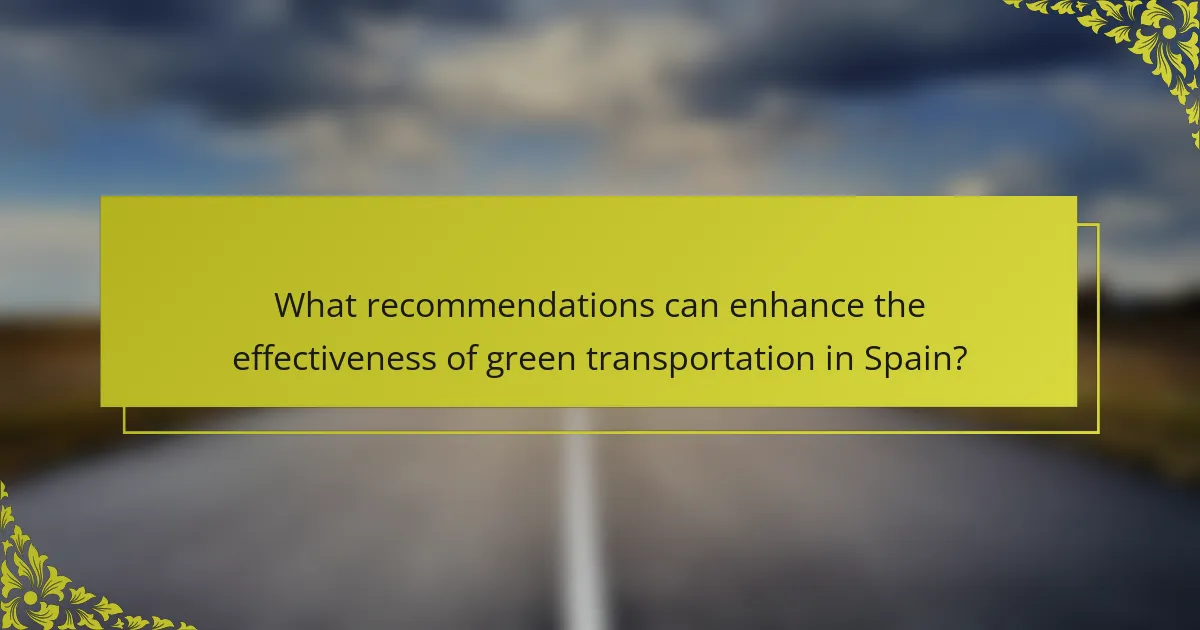
What recommendations can enhance the effectiveness of green transportation in Spain?
To enhance the effectiveness of green transportation in Spain, focus on increasing infrastructure and public awareness. Expanding electric vehicle charging stations improves accessibility. Promoting cycling through dedicated lanes encourages eco-friendly commuting. Implementing incentives for using public transport can boost ridership. Lastly, integrating technology for real-time updates enhances user experience.
What best practices should users follow when utilizing green transportation options?
Users should prioritize safety, efficiency, and sustainability when utilizing green transportation options in Spain. First, choose public transport like buses and trains that have low emissions. Second, consider cycling or walking for short distances to reduce carbon footprint. Third, use electric vehicles or car-sharing services to minimize individual car use. Lastly, stay informed about local initiatives promoting green transport, such as incentives for electric vehicles or bike-sharing programs. Following these practices enhances personal well-being and contributes to environmental sustainability.
How can local governments improve green transportation initiatives?
Local governments can enhance green transportation initiatives by investing in infrastructure, promoting public transit, and encouraging cycling. These steps improve air quality and reduce traffic congestion.
1. Develop dedicated bike lanes to ensure safety and accessibility for cyclists.
2. Increase the availability of electric vehicle charging stations to support EV adoption.
3. Implement subsidies or incentives for public transportation use to encourage ridership.
4. Launch educational campaigns to raise awareness about the benefits of green transportation options.
5. Collaborate with local businesses to create carpool programs and shared mobility solutions.
These actions can significantly contribute to a sustainable urban environment in Spain.
What community engagement strategies can promote greener travel habits?
Community engagement strategies that promote greener travel habits include awareness campaigns, local partnerships, and incentives for sustainable transportation. These strategies encourage community involvement and foster a culture of eco-friendly practices.
Awareness campaigns can highlight the benefits of green transportation options, such as reduced carbon emissions and improved public health. Local partnerships with businesses and organizations can create a network that supports sustainable travel initiatives. Incentives, like discounts for using public transport or rewards for carpooling, motivate individuals to adopt greener habits.
As a result, these strategies can significantly increase the adoption of green transportation options in Spain, contributing to a healthier environment and community.




